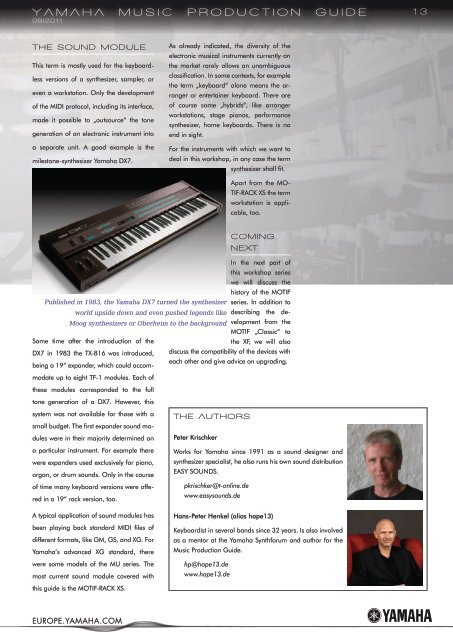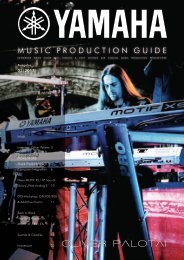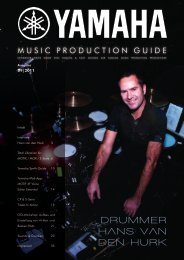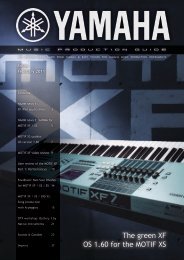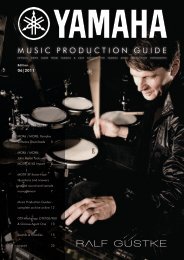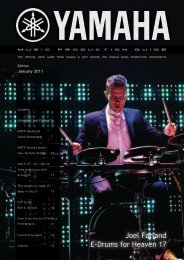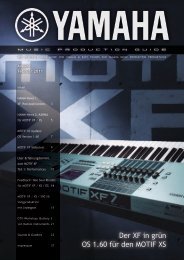Drummer Hans van Den Hurk - EasySounds
Drummer Hans van Den Hurk - EasySounds
Drummer Hans van Den Hurk - EasySounds
You also want an ePaper? Increase the reach of your titles
YUMPU automatically turns print PDFs into web optimized ePapers that Google loves.
YamaHa musIC PrODuCtIOn GuIDe<br />
09|2011<br />
tHe sOunD mODule<br />
This term is mostly used for the keyboard-<br />
less versions of a synthesizer, sampler, or<br />
even a workstation. Only the development<br />
of the MIDI protocol, including its interface,<br />
made it possible to „outsource“ the tone<br />
generation of an electronic instrument into<br />
a separate unit. A good example is the<br />
milestone-synthesizer Yamaha DX7.<br />
In the next part of<br />
this workshop series<br />
we will discuss the<br />
history of the MOTIF<br />
Published in 1983, the Yamaha DX7 turned the synthesizer series. In addition to<br />
world upside down and even pushed legends like describing the de-<br />
Moog synthesizers or Oberheim to the background velopment from the<br />
MOTIF „Classic“ to<br />
Some time after the introduction of the<br />
the XF, we will also<br />
DX7 in 1983 the TX-816 was introduced, discuss the compatibility of the devices with<br />
each other and give advice on upgrading.<br />
being a 19“ expander, which could accommodate<br />
up to eight TF-1 modules. Each of<br />
these modules corresponded to the full<br />
tone generation of a DX7. However, this<br />
system was not available for those with a tHe autHOrs<br />
small budget. The first expander sound modules<br />
were in their majority determined on Peter Krischker<br />
a particular instrument. For example there Works for Yamaha since 1991 as a sound designer and<br />
were expanders used exclusively for piano, synthesizer specialist, he also runs his own sound distribution<br />
EASY SOUNDS.<br />
organ, or drum sounds. Only in the course<br />
of time many keyboard versions were offe- pkrischker@t-online.de<br />
www.easysounds.de<br />
red in a 19“ rack version, too.<br />
A typical application of sound modules has<br />
been playing back standard MIDI files of<br />
different formats, like GM, GS, and XG. For<br />
Yamaha‘s ad<strong>van</strong>ced XG standard, there<br />
were some models of the MU series. The<br />
most current sound module covered with<br />
this guide is the MOTIF-RACK XS.<br />
EUROPE.YAMAHA.COM<br />
As already indicated, the diversity of the<br />
electronic musical instruments currently on<br />
the market rarely allows an unambiguous<br />
classification. In some contexts, for example<br />
the term „keyboard“ alone means the arranger<br />
or entertainer keyboard. There are<br />
of course some „hybrids“, like arranger<br />
workstations, stage pianos, performance<br />
synthesizer, home keyboards. There is no<br />
end in sight.<br />
For the instruments with which we want to<br />
deal in this workshop, in any case the term<br />
synthesizer shall fit.<br />
Apart from the MO-<br />
TIF-RACK XS the term<br />
workstation is applicable,<br />
too.<br />
COmInG<br />
neXt<br />
<strong>Hans</strong>-Peter Henkel (alias hape13)<br />
Keyboardist in several bands since 32 years. Is also involved<br />
as a mentor at the Yamaha Synthforum and author for the<br />
Music Production Guide.<br />
hp@hape13.de<br />
www.hape13.de<br />
13


